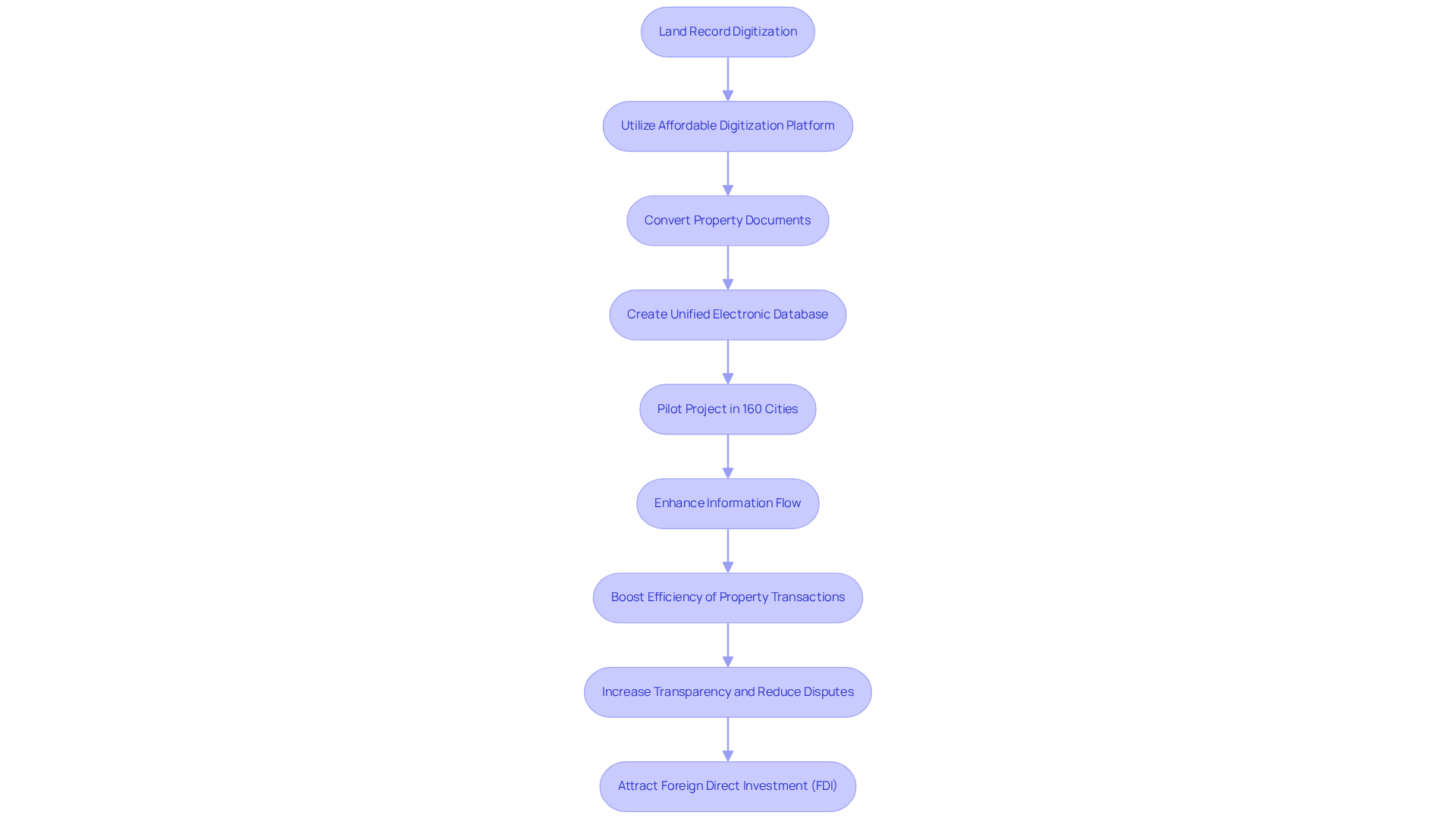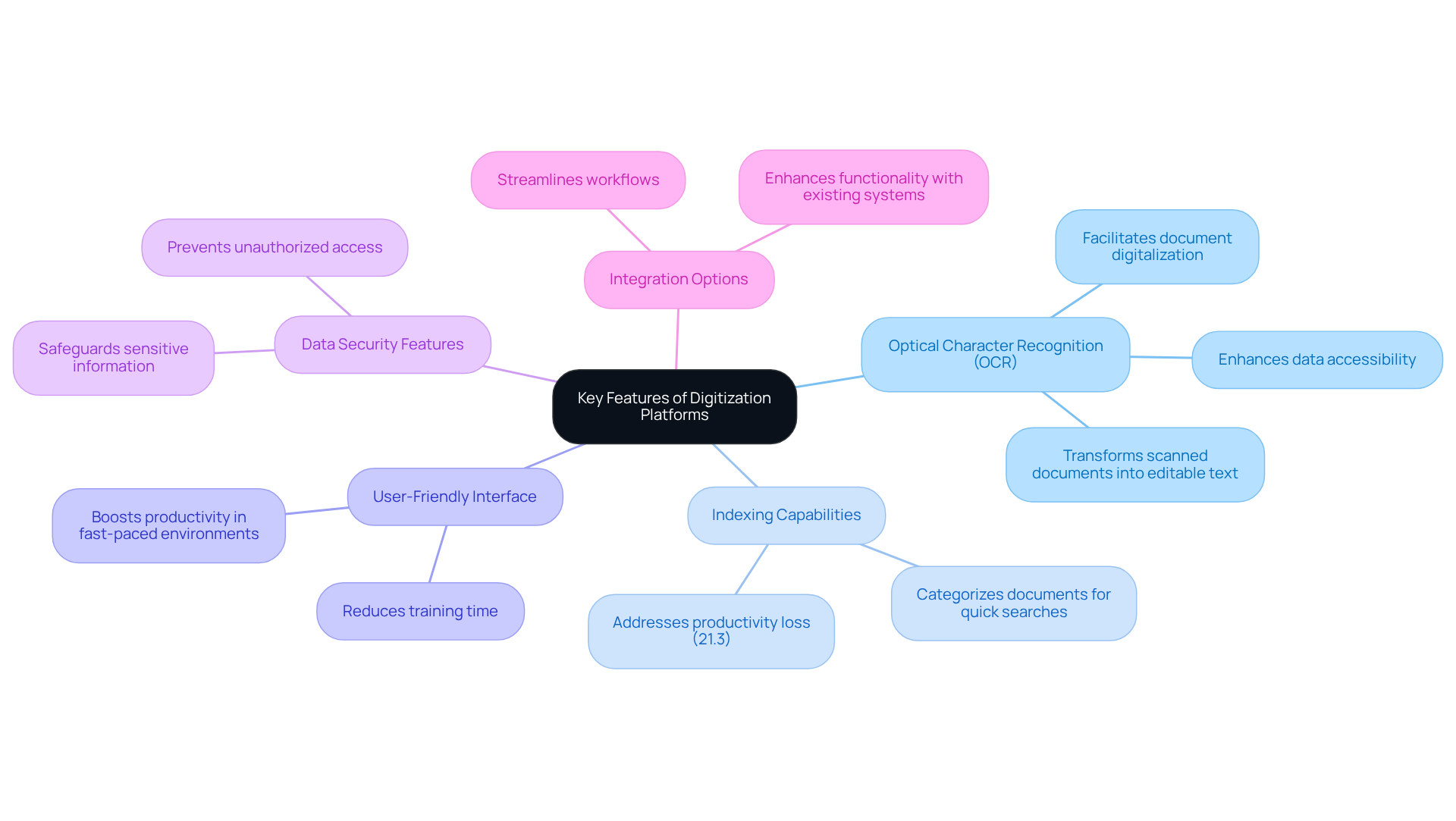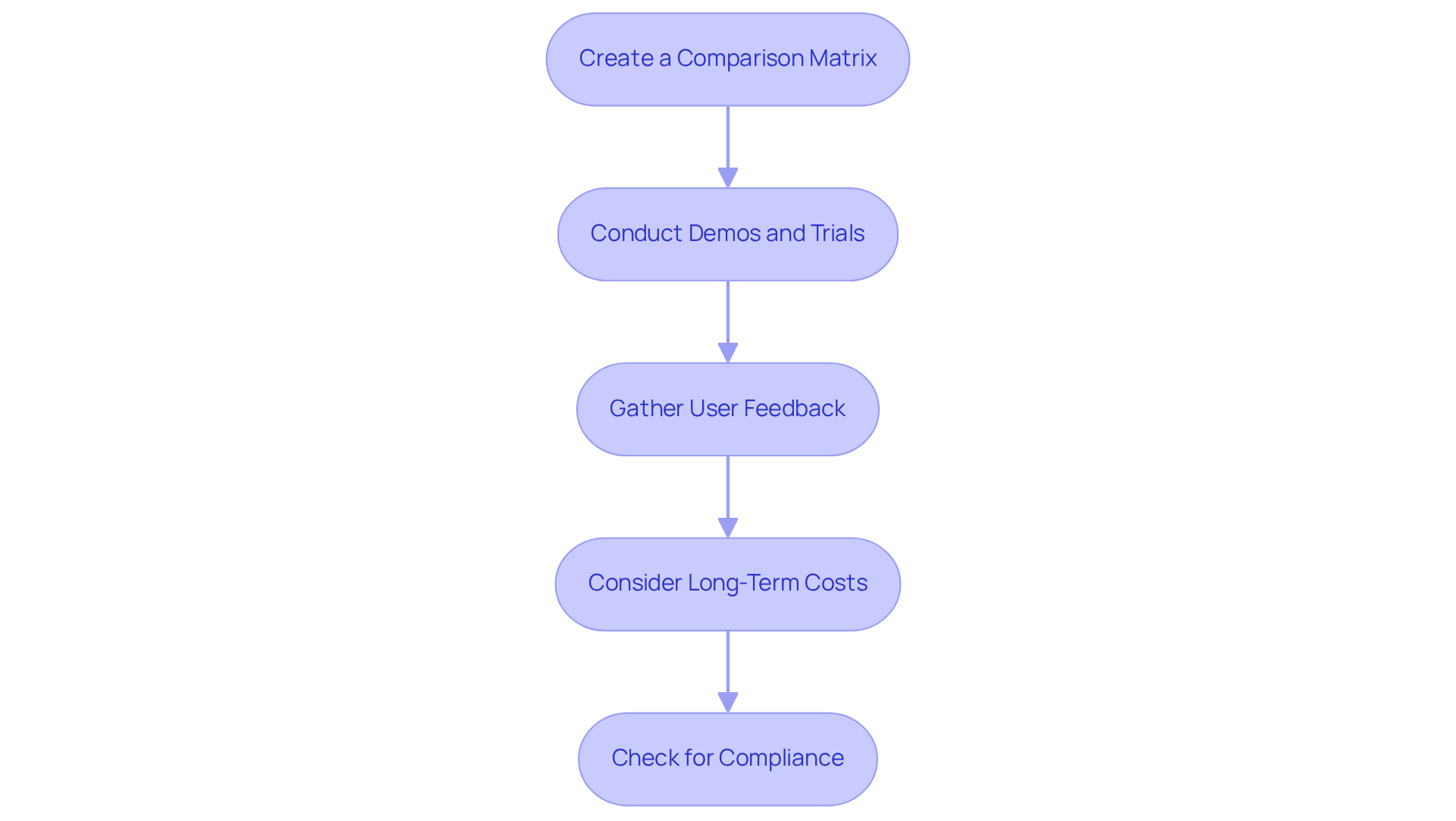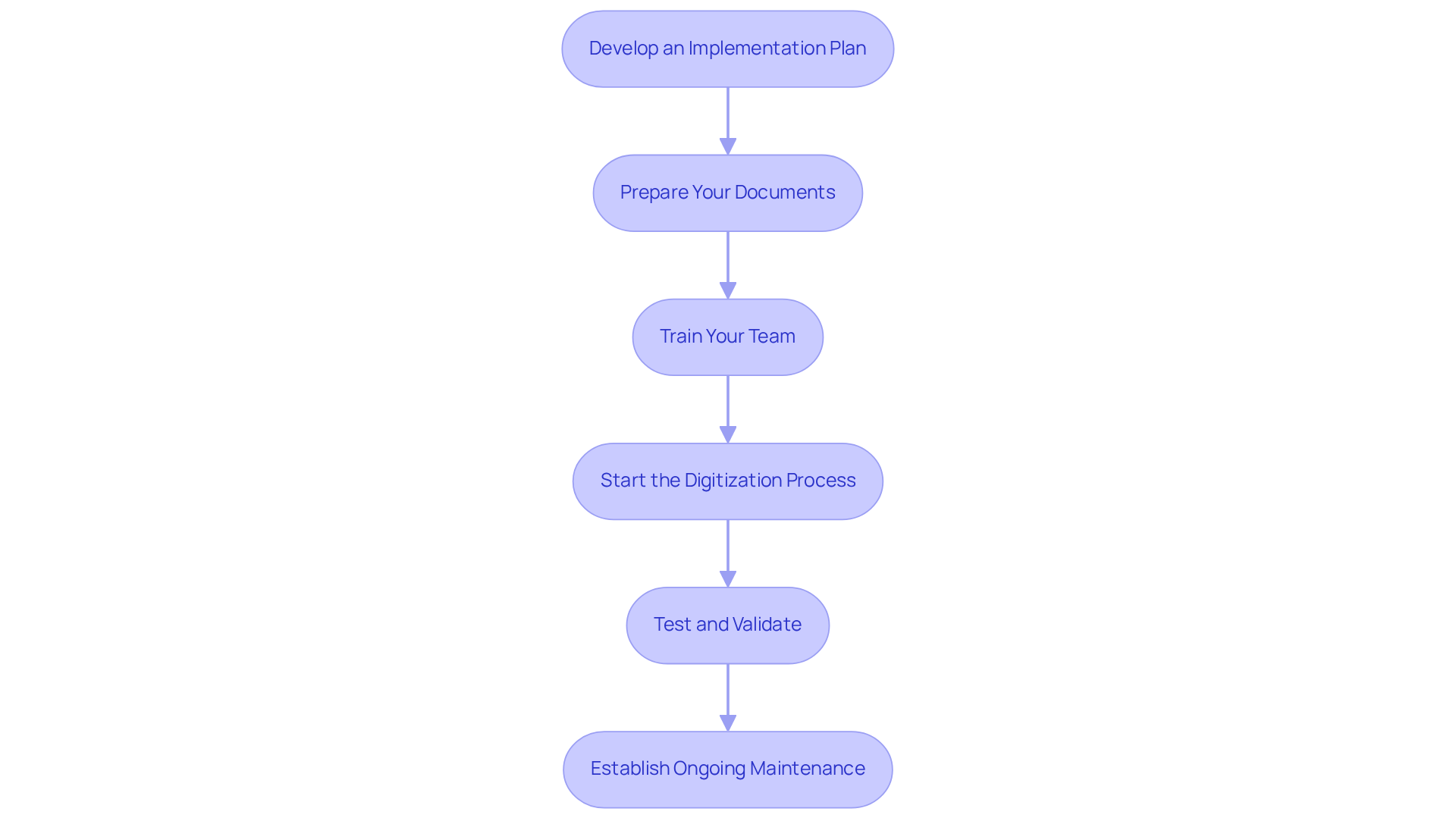Overview
The article delineates a four-step process for mastering affordable land record digitization. This process encompasses:
- Understanding digitization
- Identifying key features of platforms
- Evaluating options
- Implementing the selected system
Such a structured approach is bolstered by insights into how digitization enhances efficiency, accessibility, and transparency in property management. Ultimately, these improvements foster a more effective real estate market.
Introduction
The transition from paper to digital records in property management is not merely a trend; it signifies a fundamental shift in the management of land ownership and transactions. Embracing affordable land record digitization enables organizations to unlock a multitude of benefits, including:
- Enhanced accessibility
- Improved efficiency
- Increased transparency in real estate dealings
However, the path to successful digitization is fraught with challenges, ranging from selecting the appropriate platform to ensuring data security and compliance. Consequently, stakeholders must navigate this complex landscape and implement effective digitization strategies that can truly transform property management.
Understand Land Record Digitization
The digitization of property documents using an represents a pivotal transformation of physical files into , a crucial advancement in modernizing . This transformation not only enhances document accessibility but also significantly boosts the efficiency of by utilizing an affordable land record digitization platform.
By utilizing an affordable land record digitization platform to convert property documents into digital formats, organizations can preserve while enabling rapid searches and retrievals, thus improving accessibility. This initiative is particularly vital as the government aims to establish an affordable land record digitization platform that will create a unified electronic property record database, encompassing both rural and urban regions, which will clearly delineate ownership and .
Currently, a pilot project for terrain digital mapping is underway in 160 cities under the Naksha initiative, showcasing tangible progress in this domain. The is expected to reduce disputes and bolster investor confidence, as an affordable land record digitization platform will increase transparency and simplify verification to facilitate land transactions.
As Banikinkar Pattanayak notes, the initiative is designed to enhance information flow and mitigate disputes, which is essential for cultivating an affordable land record digitization platform that promotes a more efficient real estate market. Furthermore, digitized documents are (FDI). Ashish Sharma emphasizes that these reforms are vital for unlocking substantial foreign investment and ensuring sustainable growth in Indian real estate.
Understanding these advantages is the first step toward implementing an that utilizes an affordable land record digitization platform to safeguard documents and foster a more efficient and transparent real estate market.

Identify Key Features of Digitization Platforms
When selecting an , it is crucial to identify key features that will enhance the efficiency of land record management. Consider platforms that provide the following:
- : This technology transforms scanned documents into editable and searchable text, simplifying information retrieval. OCR significantly enhances , facilitating document digitalization and data extraction.
- Indexing Capabilities: Effective indexing enables users to categorize and organize documents based on various criteria, such as parcel numbers or owner names, which streamlines quick searches. Notably, document management issues contribute to 21.3% of productivity loss in the workplace, underscoring the urgency of addressing these challenges.
- : A system with an intuitive interface allows users to navigate effortlessly, reducing training time and boosting productivity. This aspect is particularly vital in fast-paced environments, where efficiency can directly influence management fees, typically ranging from 8% to 12%.
- : It is essential to ensure that the system incorporates robust security measures to safeguard sensitive information from unauthorized access.
- : The capability to integrate with existing systems, such as GIS or property management software, enhances overall functionality and streamlines workflows.
By focusing on these attributes, real estate professionals can select an affordable land record digitization platform that not only fulfills their operational needs but also enhances efficiency across their workflows. With over 326,000 businesses positioned to achieve , making the right choice can lead to substantial advancements in property management.

Evaluate and Compare Digitization Options
To effectively evaluate and compare digitization options for land records, consider the following steps:
- Create a : Develop a matrix that lists essential features such as pricing, customer support, and user reviews. This organized method enables a clear visual comparison of how each system fulfills your specific needs.
- Conduct Demos and Trials: Take advantage of free trials or demonstrations provided by many services. Engaging with the software firsthand will provide valuable insights into its , helping you make an informed decision.
- Gather User Feedback: Investigate online reviews and testimonials from other real estate professionals. Recent statistics indicate that before purchasing business software, underscoring the importance of user feedback in the evaluation process. This feedback is vital as it illuminates the system's reliability and the quality of customer service, which can greatly influence your operations.
- Consider Long-Term Costs: Assess not only the initial costs but also any ongoing fees for maintenance, updates, or additional features. Understanding the of an platform is essential to ensure it aligns with your budget and anticipated return on investment.
- Check for Compliance: Confirm that the system complies with applicable regulations and standards for data security and privacy, especially when handling sensitive property information. Compliance is crucial to mitigate risks associated with data breaches and to ensure the integrity of your operations.
By following these steps, you can make a well-informed choice that enhances your . Furthermore, consider referencing case studies such as "," which illustrate the benefits of transitioning to digital systems.

Implement Your Chosen Digitization Platform
To effectively implement your chosen digitization platform, follow these essential steps:
- Develop an Implementation Plan: Create a comprehensive timeline that specifies the resources and staff needed for the . Incorporate milestones to monitor progress and ensure accountability.
- Prepare Your Documents: Before scanning, meticulously organize and clean your physical records. Remove any staples or bindings that could potentially harm the scanner, ensuring a smooth scanning process.
- Train Your Team: Conduct for your staff to familiarize them with the new platform. Concentrate on the attributes and capabilities that will improve their workflow, as efficient training is vital for optimizing the advantages of digital transformation.
- Start the Digitization Process: Initiate the scanning of documents according to your established plan. Consistently oversee the process to uphold quality and precision, as these elements are essential for .
- Test and Validate: Once digitization is complete, rigorously test the system to confirm that all documents are correctly indexed and searchable. Verify the digital information against tangible documents to ensure accuracy and reliability.
- Establish Ongoing Maintenance: Implement a , which should include regular backups and system updates. This practice is essential for ensuring continued efficiency and security of your digitized assets.
By following these steps, organizations can optimize their digital transformation efforts by utilizing an , significantly reducing the time and expenses associated with traditional methods. As the is projected to reach $3.9 trillion by 2027, investing in effective digitization strategies is more critical than ever.

Conclusion
The journey toward affordable land record digitization transcends the mere shift from paper to digital; it embodies a pivotal modernization of property management systems. This transformation not only enhances accessibility but also streamlines transactions and fosters transparency in the real estate market, ultimately benefiting all stakeholders involved.
Key insights from the article underscore the necessity of selecting the right digitization platform, with a focus on essential features such as:
- Optical Character Recognition
- User-friendly interfaces
- Robust data security
Evaluating options through comparison matrices, user feedback, and understanding long-term costs are critical steps in making an informed decision. Furthermore, a well-structured implementation plan is vital to ensure that organizations can effectively transition to digital systems, maximizing efficiency while minimizing disruption.
In a rapidly evolving digital landscape, embracing land record digitization is no longer merely an option; it is a necessity for real estate professionals aiming to enhance operational efficiency and attract investment. By prioritizing these strategies, stakeholders can contribute to a more transparent and efficient real estate market, paving the way for sustainable growth and innovation in the sector. Taking action now will ensure that organizations remain competitive and responsive to the demands of a modern economy.
Frequently Asked Questions
What is land record digitization?
Land record digitization is the process of converting physical property documents into digital formats, which modernizes property management systems and enhances document accessibility.
What are the benefits of using an affordable land record digitization platform?
An affordable land record digitization platform improves the efficiency of property transactions, preserves historical records, allows for rapid searches and retrievals, and enhances transparency in land ownership.
How does the government plan to implement land record digitization?
The government aims to establish a unified electronic property record database that includes both rural and urban regions to clearly delineate ownership and improve information flow.
What is the Naksha initiative?
The Naksha initiative is a pilot project currently underway in 160 cities that focuses on terrain digital mapping as part of the land record digitization efforts.
How will digitization reduce disputes in property transactions?
By increasing transparency and simplifying verification processes, land record digitization is expected to reduce disputes and bolster investor confidence in property transactions.
What role does digitization play in attracting foreign direct investment (FDI)?
Digitized documents are critical for attracting FDI as they enhance transparency and efficiency in the real estate market, which is essential for unlocking substantial foreign investment.
What is the overall goal of implementing land record digitization?
The overall goal is to foster a more efficient and transparent real estate market by safeguarding documents and enhancing information flow, which is vital for sustainable growth in the sector.




